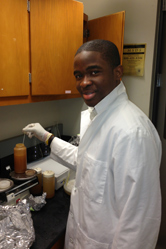Biochemistry
“Expression of the Murine Leukemia Virus CANC Domains of the Gag Polyprotein and 5’ Untranslated Region of the Genome”

The Human Immunodeficiency Virus (HIV) is a retrovirus that causes Acquired Immunodeficiency Syndrome (AIDS) in humans. The Murine Leukemia Virus (MLV) is a retrovirus that causes cancer in mice. MLV and HIV share a common life cycle and use the same structural proteins. MLV is simpler than HIV, lacking accessory proteins and possessing a smaller genome, making MLV a great animal model for studies of the viral structural proteins and genome. The Gag polyprotein is essential to the assembly of new virus particles in both HIV and MLV. Gag consists of three domains; Matrix, Capsid, and Nucleocapsid. Nucleocapsid binds to the viral RNA at the 5’ untranslated region (UTR) during assembly and Capsid engages in Gag-Gag lattice interactions but has been shown to play a role in Gag-RNA interaction. Our project focuses on the expression, purification, and concentration of the Capsid and Nucleocapsid domains (CANC), as well as the 5’ UTR of the MLV genome. We have successfully expressed CANC in BL21 DE3 E. Coli cells and employed a GST fusion tag system to purify CANC followed by cation exchange. We were using a hammerhead ribozyme to aid in the expression of the target RNA sequence by T7 polymerase, but we are currently attempting a different approach for RNA expression using a non-native construct which has GA nucleotides inserted at the 5’. We aim to carry out gel shift assays which will provide useful information on the protein-RNA interactions.
This research is funded in part by NIH grant R01AI81604 and the Howard Hughes Medical Institute.
What research have you been doing this summer?
I have been working on transcription of the 5’ untranslated region of the Moloney Murine Leukemia Virus (MLV) genome in the structural biology lab of Dr. Michael F. Summers.
How did you find out about this opportunity?
I got this opportunity by emailing Dr. Summers and asking for a position in his lab and I was interviewed by him. There was no formal application process.
Who did you work with on this project?
I work with Dr. Summers, Deborah Girma (my grad student mentor), and Alex Emmanuelli, a biochemistry senior.
Was this your first independent research project?
No it’s my second involvement in research
Do you get course credit for this work or get paid? How much time do you put into it?
During the summer I put in 40 hours a week but during the school year I will be working 8-10 hours weekly. This was a paid position.
What academic background did you have before you started?
I had finished two years of general and organic chemistry as well as three of the four biology courses required for biochemistry majors.
How did you learn what you needed to know to be successful in this summer project?
The project involved a lot of hands-on learning. I received on-the-job training from my graduate student.
What has been the hardest part about your work this summer?
The initial learning curve period; the time it took for me to get used to working in this lab.
What was the most unexpected thing?
The coolest thing about my lab is the willingness to teach and be taught displayed by everyone. We have a great working environment.
How does this research experience relate to your course work?
It is a biochemistry lab and I am a biochemistry major so there is perfect correlation between research and coursework.
What is your advice to other students about getting involved in research?
Apply quickly and apply early. Email professors asking about positions in their labs, talk to friends who are currently in labs asking if there are openings. Read up on the work done by the researchers at UMBC and apply to whatever interest you. If you have the chance to interview, prepare for it and be confident.
What are your career goals?
I plan to go to medical school and get an MD/PhD after my time at UMBC
What else are you involved in on campus?
I work with the SGA, I’m a member of UMBC National Residence Hall Honorary (NRHH), I’m a member of Minority Association of Premedical Students, (MAPS), and I’m involved with Bethel Campus Fellowship.
7/23/2013